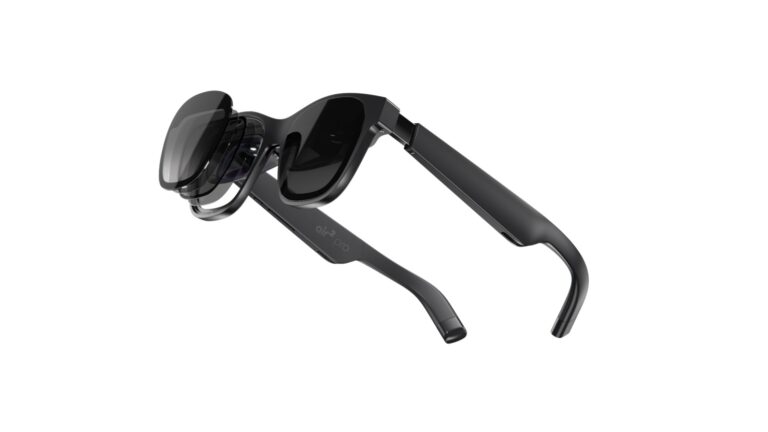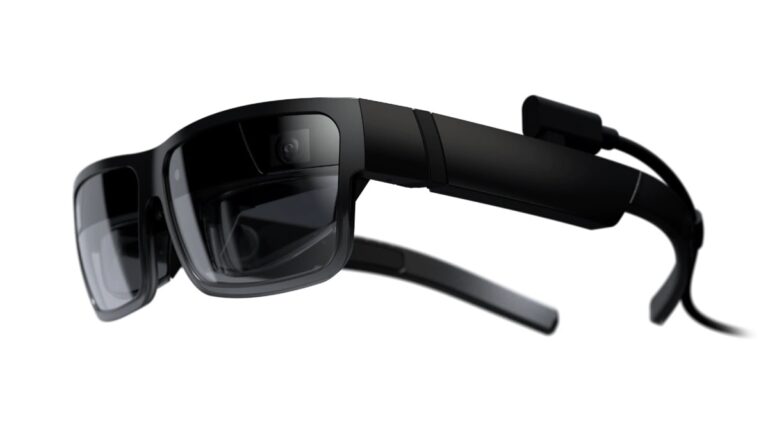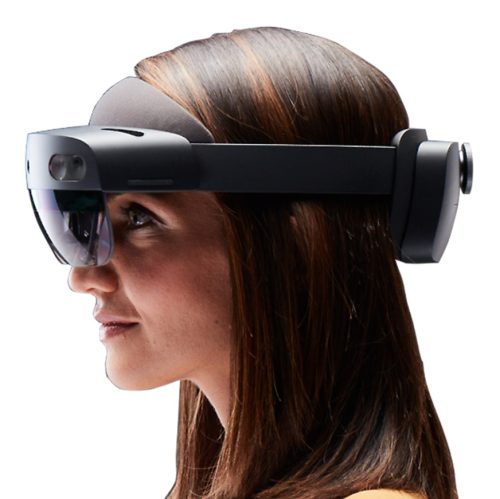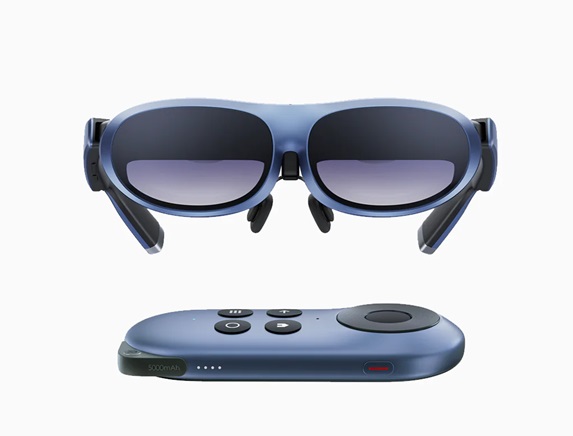
Augmented reality (AR) glasses are wearable devices that blend digital elements into the user’s real-world environment. The AR smart glasses are designed to project information through digital mediums. Wearable lenses are used to digitally project information.
Considering modern needs and with a focus on augmenting reality, it is essential to review a list of the best AR glasses to buy in 2024. Unlike virtual reality headsets that fully immerse users into a simulated environment, AR glasses overlay graphics, videos, or other enhancements over what the user sees in their surroundings.
AR glasses have applications in different aspects of life. The glasses provide easy access to helpful information, play AR games, view directions and translations on the lenses of the glasses, and more. The built-in cameras, sensors, and processing units enable advanced features like facial recognition, environment mapping, and object detection.
Many major technology companies like Microsoft, Google, Apple, and Snap are investing heavily in AR glasses and headsets. As the hardware and software continue advancing rapidly, AR glasses are poised to become the next big platform for consumer and enterprise applications. Several factors need to be considered when choosing the AR Glassescase. You should look into display quality, interface, controls, battery life, comfort, and wearability. In addition, the availability of AR apps and capabilities.
Table of Contents
Our List of The Best AR Glasses to Buy in 2024
Why We Picked XReal Air 2 Pro
Xreal Air 2 Pro AR glasses are advanced display glasses containing multiple features. The display of these AR glasses comes with 0.55 Micro OLED panel from SONY. The glasses deliver exceptional visual clarity with a 1080p resolution per eye and a refresh rate of up to 120Hz.
The XReal Air 2 Pro glasses connect to multiple devices via USB, like game consoles, laptops, phones, and more.
The glasses also feature a proximity sensor, and you can attach Go Pro to capture moments.
The XReal Air 2 glasses are ideal for gameplay as they have a high refresh rate of up to 120Hz. These glasses are also ideal for traveling as they allow you to enjoy movies and view content from laptops.
Xreal Air AR 2 Pro offers 2 built-in stereo speakers and 2 microphones to enjoy smooth audio
It has multiple touch controls and comes with three nose pads. They feature innovative electrochromic dimming capabilities, allowing users to adjust the brightness of the lenses for improved viewing in various lighting conditions.
The adjustable design with a prescription lens frame and 3-position temple adjustment offers an economical design The XReal Air 2 glasses are also lightweight and comfortable, making them suitable for extended use.
The glasses are compatible with screen mirroring and XREAL Beam. You will also love multiple buttons for screen on/off button and screen brightness adjustment
Specifications
- Display: Micro OLED panel with 46 degree FOV, 120 Hz
- Peak brightness: 500 nits
- Audio: Directional audio with two microphones
- Weight: 75g
- Connectivity: USB-C display port
Key Features
- Electrochromic dimmable lenses for adjustable brightness
- High-resolution 1080p displays for each eye
- 120Hz refresh rate for smooth visuals
- 3DoF tracking for immersive experiences
- USB-C connectivity for easy device pairing
Pros:
- Excellent visual clarity with 1080p resolution per eye
- Electrochromic dimming for enhanced viewing
- Lightweight and comfortable design
- High refresh rate of up to 120Hz
- Enjoy projection of digital information or entertainment with Projector AR
Cons:
- Audio can be tinny at loud volumes
- The companion app is a bit clunky
- Setup can be tricky for first-time AR users
Why We Picked Lenovo ThinkReality A3
Lenovo ThinkReality A3 comes in two editions: the PC edition and the business edition. Both the editions come in a carrying case with a USB data cable and other accessories.
The AR glasses feature a Qualcomm XR-1 processor, dual 1080P display, and multiple cameras. The cameras are ideal for precision room scale training.
Lenovo ThinkReality A3 also features a built-in stereo speaker and microphones integrated with noise suppression. The glasses are compatible with prescription lenses as well.
Specifications
- Display: The glasses offer a display of 1080p resolution per eye up to 200 nits
- Processor: You can enjoy the Qualcomm Snapdragon XR1 platform
- Audio: Integrated stereo speakers and 3 Noise-suppressing microphones
- Camera: The glasses feature multiple 8MP RGB cameras to record moments and experiences.
- Connectivity: Offers the best connectivity with USB-C 3.2 Gen 1
- Weight: Lightweight up to 130g
Key Features
- Flexible to connect with multimedia content from Motorola phones
- Shows compatibility with laptops and PCs via the USB C port
- You can view multiple virtual monitors and workspaces
- Collaborate with remote team members in augmented virtual meetings
- Lenovo enterprise software platform for custom apps and solutions
- Spatial mapping, object detection, and depth sensing
Pros:
- Powerful processing for graphically rich applications
- Rugged yet comfortable industrial design
- A future-focused platform for custom development
- Interoperability with Motorola devices
Cons:
- Need modern computers to connect and function
- The app ecosystem is still maturing
- Wired connectivity limits flexibility
Engo Eyewear Engo 2: Best for Outdoor Activities
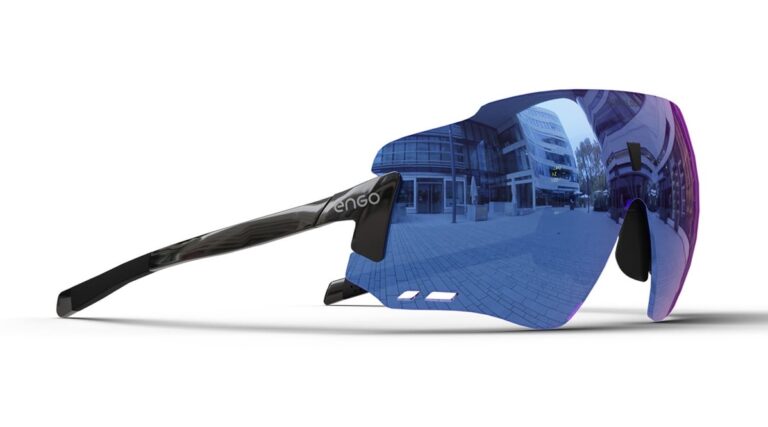
Why We Picked Engo Eyewear Engo 2
Engo eyewear Engo 2 is a cycling and running glasses with Augmented reality. The glasses involve a built-in heads-up display to record and get real-time performance data.
The glasses are compatible with a watch or cycling computer to check the heart rate, power, pace, distance, etc. Engo eyewear Engo 2 also features gesture control that lets you quickly change data screens with a simple hand gesture.
Specifications
- Lens Technology: 3 polycarbonate lenses with high-definition view
- Battery Life: Up to 12 hours of continuous use
- Charging time: 3 hours
- Connectivity: Bluetooth 4.2
- Weight: 36 g (Standard), 41 g (Large)
Key Features
- Engo eyewear Engo 2 offers a 12-hour battery and a micro OLED projector, ensuring a clear data display.
- You can enjoy hand gesture module control to change data screens
- Edge sense touch interface to control projections and menus
- Environmental sensors for mapping terrain, objects, and physical spaces
- Assistive tools for sports tracking, mapping directions, and fitness goals
- Designed to withstand dust, shocks, heat, and submersion in water
Pros:
- Instant feedback to adjust with real-time metrics.
- Compatible with a watch or cycling computer
- Allows dynamic informational overlays without impeding natural sight
- Rugged build quality for active outdoor use
- Long battery life compared to alternatives
- Responsive edge touch controls
- Voice assistant integration
Cons:
- The micro-mirror projection has a small field of view
- Edge interface induces learning curve
- Few third-party apps optimize full capabilities
Microsoft HoloLens 2: Best AR glasses for collaboration
Why We Picked Microsoft HoloLens 2
Microsoft HoloLens 2 operates on a Windows Holographic operating system based on a “flavor” of Windows 10. Ideal for users, administrators, and developers to enjoy a robust and secure platform.
The highlight feature of the HoloLens is the depth camera, which works as a smaller version of the Kinect camera of Xbox. With powerful projection, the HoloLens can turn your walls into a webpage.
The Microsoft HoloLens 2 is compatible with some Windows 10 applications. The device can be controlled by voice, gestures, and a small controller. HoloLens headset is compatible with several games and applications.
You may refer in depth details of Microsoft HoloLens 2
Specifications
- Displays: 2K 3:2 light engines per eye
- Audio: Built-in Spatial Sound And 5 channels microphone array
- Memory: 4 GB LPDDR4x
- Storage: 64 GB
- Connectivity: Wi-Fi, Bluetooth 5, and USB C
- Camera: 8 Megapixels
- Processors: Qualcomm Snapdragon 850 compute platform
- Battery Life: 2-3 hours of active use
Key Features
- The device helps in simultaneous localization and mapping to analyze physical spaces.
- Precise hand and eye tracking enables natural gesture controls
- Anchors pin virtual objects to real-world surfaces and spaces
- Remote collaboration through Microsoft Mesh platform
- Manage the device remotely by using Microsoft Intune or any preferred solution
Pros:
- Allows to Act with precision
- Fully articulated hand-tracking
- Connect with remote colleagues in real-time
- Robust environment scanning capabilities
- Share data like photos or video
- Collaborative tools for multi-user experiences
Cons:
- Very expensive professional pricing
- Limited battery life
- Locked into a Microsoft-centric ecosystem
Why We Picked Rokid Max
The AR Video glasses offer a 215-inch viewing experience with 1080p Full HD video and screen resolution. This version offers a 120hz refresh rate, ideal for gaming and movie watching.
The device includes built-in speakers that can be connected to a tablet, game console, or computer.
Rokid Max AR glasses are just 75 grams in weight and can easily connect to a computer; thus, they are ideal for traveling.
The 215-inch viewing capacity allows you to enjoy movies like a movie theater experience. Rokid Max AR glasses come with a cover attached to them, allowing them to work as a VR device.
Specifications
- Display: FHD 1920×1080 resolution with 50 degrees FOV, 600 nits
- Battery: No in-built battery
- Audio: Built-in 2 HD Directional speakers with 2 noise-canceling microphones with AI Voice Control
- Connectivity: USB-C and OTG
- Sensors: Enhanced 9-axis (IMU), 3DoF Head tracking and wearing detection
Key Features
- Navigate between 2D and 3D content
- Compatible with Phone, tablet, console, and more
- Enjoy screen privacy with 90% light leakage reduction
- Create 3D maps of people, objects, and spaces for contextual interactions
- Stream YouTube, games, and social media on the immersive display
- Pause and zoom detail views during video playback
Pros:
- Max’s OLED screen supports up to 600 nits of brightness.
- No corrective lenses and support clear vision for nearsighted users
- Truly immersive video and 3D AR imagery
- Future-proofed with advanced hardware
Cons:
- It is expensive for most consumers
- Vision can take adjustments for first-time users
- Few experiences optimized for glasses yet
Vuzix Blade Upgraded: Best AR glasses for remote access
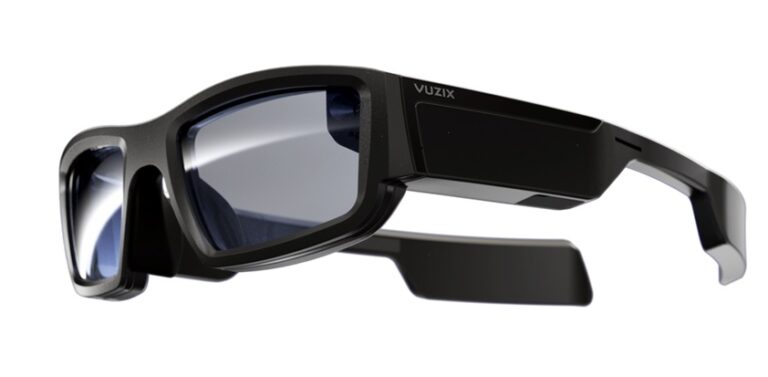
Why We Picked Vuzix Blade Upgraded
Vuzix Blade Upgraded or Vuzix Blade 1.5 version is an AR glass that comes with a micro USB cord and charging in the case.
The glasses operate hand-free operations for recording videos and capturing photos.
Smart glasses are ideal for training. The glasses can also used for showing content related to jobs, business, etc.
Vuzix Blade Upgraded comes with an auto-focused camera. Also, it comes with a two-nose piece, which will provide you with a comfortable experience, even in the long run.
The charger gets fixed in the case, eliminating the problem of getting stolen or lost. You can just attach the charging cable and keep the device in the case.
Specifications
- Camera: Autofocus HD camera
- Audio: Integrated stereo speakers in temples with noise-cancelling mics
- Display: Full-color display (right eye only)
- Safety Feature: Full UV protection lenses plus ANSI Z87.1 safety certification
- Connectivity: Wireless Wi-Fi and Bluetooth
Key Features
- Operate remote work instructions through digital screens and cameras
- Telepresence capabilities to transmit in real-time to other devices
- Scan QR codes, barcodes, recognize objects with computer vision
- Alexa and other voice assistant integration
- Noise-canceling microphones minimize background sounds
Pros:
- Auto-focus and Stereo Audio
- Lightweight, ergonomic design built for prolonged use
- Hands-free connection to the digital world
- certified eye protection
- Robust connectivity and remote assistance potential
- Built-in camera great for documentation
Cons:
- Limited battery life is a concern
- Minimal onboard processing power
- Strong light glare on display edges
What are the key Features to Consider when Buying an AR Headset?
Several factors need consideration when buying AR smart glasses or headsets; some of the essential aspects to consider are:
Display Quality
Display optics and technology have an enormous impact on the immersion and realism level of the augmented reality experience. Key factors here include resolution, contrast, brightness , and display technology. Most AR headsets today use small projectors to beam imagery onto the lenses or waveguides to overlaylight-based graphics onto the real world.
Resolution determines how sharp and detailed the virtual elements appear, with many premium AR glasses now offering a crisp 1080p or 4K visuals per eye. Contrast and brightness enable a vibrant, dynamic rangeof colors and imagery, even when used outdoors.
As AR headsets evolve, expectations are high for photo-realistic expansive displays that map virtual objects into the real-world backdrop with stunning visual clarity and depth while still enabling natural sight of your surroundings.
Interface and Controls
Intuitve control schemes are imperative for fluidly navigating through augmented spaces and menus. AR glasses today utilize a combination of gaze tracking, gesture tracking, voice commands, handheld controllers, and peripherals.
Eye tracking allows you to select menu options and navigation simply by focusing your gaze. At the same time, gesture controls like pinch, swipe, and grab through wrist sensors or cameras enable manipulating objects. Voice controls via AI assistants make straightforward hands-free commands feasible, but lack more nuanced input capacities.
As AR hardware and software mature in generations to come, the most intuitive navigation systems will converge some combination of these modalities, likely emphasizing more seamless hand and eye tracking. Simplifying the human-computer interface remains imperative for mass consumer adoption.
Connectivity
The compatibility of connectivity specs like Wi-Fi, Bluetooth, and USB determines how AR glasses can transfer information between other devices and access data services through the cloud. This facilitatesmulti-user shared experiences, remote assistance capabilities, and augmented spaces anchoredd across different locations.
As augmented reality meshes virtual graphics onto real-world environments, fast and reliable connectivity will help enable persistent experiences tied to specific places and objects rather than only to the individual user’s headset. This emerging concept of the Mirrorworld relies on flexible, high-band communication between AR wearables, sensors, and cloud servers.
Battery Life
While most premium AR smart glasses today only last between 1-3 hours of active use for graphically-intensive applications, expectations are that steady hardware improvements will enable all-day battery life on future generations more cocomparable to smartphone and laptop longevity.
Optimizing display brightness, CPU/GPU clock speeds, and wireless connectivity when not in active use are key ways to conserve battery life in current headsets. However, for AR wearables to achieve mainstream adoption by consumers, the ability to wear them continuously throughout daily life without concern over charging is critical.
Audio
Immersive binaural audio completes the AR experience, providing directionally accurate spatial soundscapes and acoustic depth for virtual objects and real-world sounds. Noise-canceling microphones also enable verbally controlling AR interfaces via voice assistants and online chat capabilities through the glasses.
Comfort and design
For AR glasses to feasibly replace smartphones as the next wave of everyday computing devices, as many predict, continuous wearing throughout daily life needs to remain comfortable and convenient. That means an ergonomic, lightweight design, adjustable components to fit different head shapes, breathable materials that reduce sweatiness and heat, and ideal weight distribution so glasses don’t slide down nose bridges as easily.
Aesthetic customizability is also key, as early AR glasses have faced criticism for looking awkward and bulky. As the form factor advances, fashion-forward frames that offer personal style expression while packing dense miniaturized components will help drive consumer appeal and make AR wearables an attractive social accessory.
Conclusion
Augmented reality glasses are reaching impressive stages of development from numerous competing manufacturers. As the technology matures, smarter processing, improved displays and optics, stronger connectivity, and longer battery life will enable more ubiquitous and reliable experiences.
While the selection today still focuses on niche professional use cases, we anticipate AR glasses becoming widely embraced by general consumers over the next 3-5 years for applications from navigation to gaming and spatial computing once untethered all-day wear becomes feasible.
Suppose even a fraction of smartphone users adopt AR wearables as their next computing platform. In that case, we may soon look back at the era of shrinking down desktop interfaces to pocket-sized touchscreens as a temporary stopgap on the way toward accessing the internet directly from our senses of sight, sound , and touch.
As augmented reality trends towards the apex of the hype cycle shortly, we expect the pioneers in today’s AR headset market to compete heavily on refining comfort and aesthetics without compromising on functionality. The most promising devices will balance battery efficiency, connectivity, display resolution, and intuitive controls into sleek eyeglass frames suitable for continuous wear in everyday life.
Frequently Asked Questions (FAQs)
Q1 Are AR Glasses Safe for Vision?
Yes, reputable AR glasses utilize non-harmful light waves and intensities that have not shown negative effects in medical testing and trials. Some glasses, like the Razer Anzu, even filter blue light for eye protection. That said, use cases that strain focus, like reading small text, may cause fatigue quicker.
Q2 Can You Wear Prescription Glasses with AR Glasses?
Some AR glasses allow interchangeable lens inserts for vision prescriptions. Alternatively, custom prescription lenses can be ordered for a subset of AR frames. As the market grows, most future headsets will support prescriptions through modular components.
Q3 Do AR Glasses Work with iOS and Android Phones?
Certain AR glasses support connectivity with iOS and Android devices for shared content viewing, communication capabilities, and controller pairing. However, native app support does vary across headsets. HoloLens and Vuzix Blade cater more to iOS, while Rokid favors Android optimization.
Q4 What Does Hands-free Mean for AR Glasses?
Hands-free refers to AR glasses that use intuitive controls like eye tracking, head tracking, or voice commands. This allows users to freely use their hands while directing the AR interface with sight, sound , and minimal gestures.
Q5 Can AR Glasses Translate Languages?
Yes, select AR glasses integrate real-time translation powered by cloud connectivity. As the camera inputs foreign text imagery, processors route it through APIs like Google Translate to overlay the English translation directly within the display.
